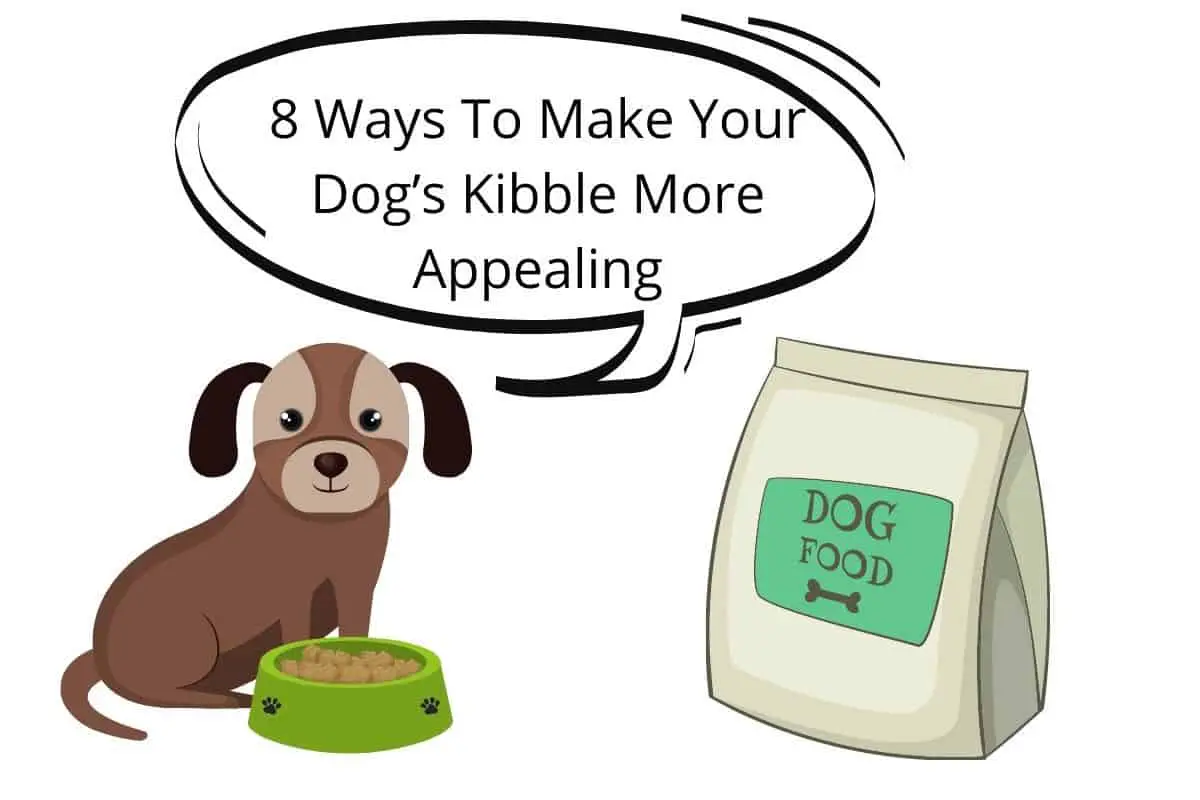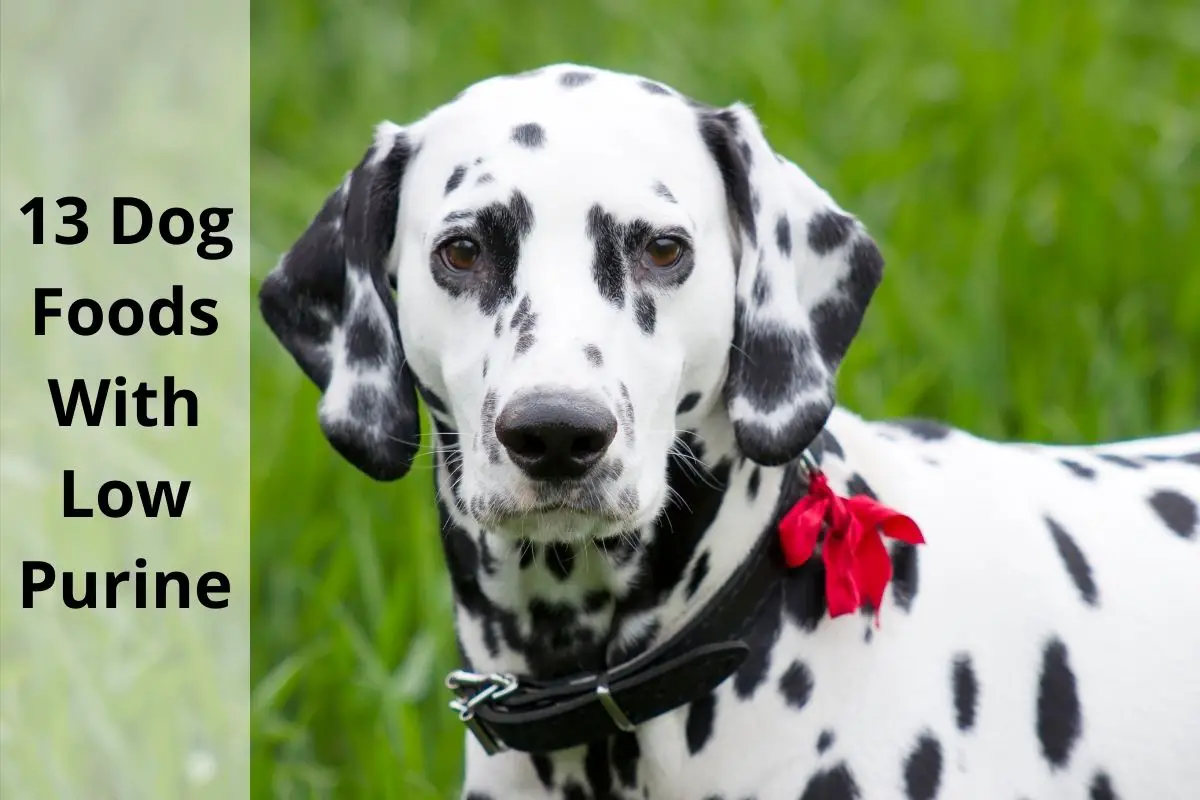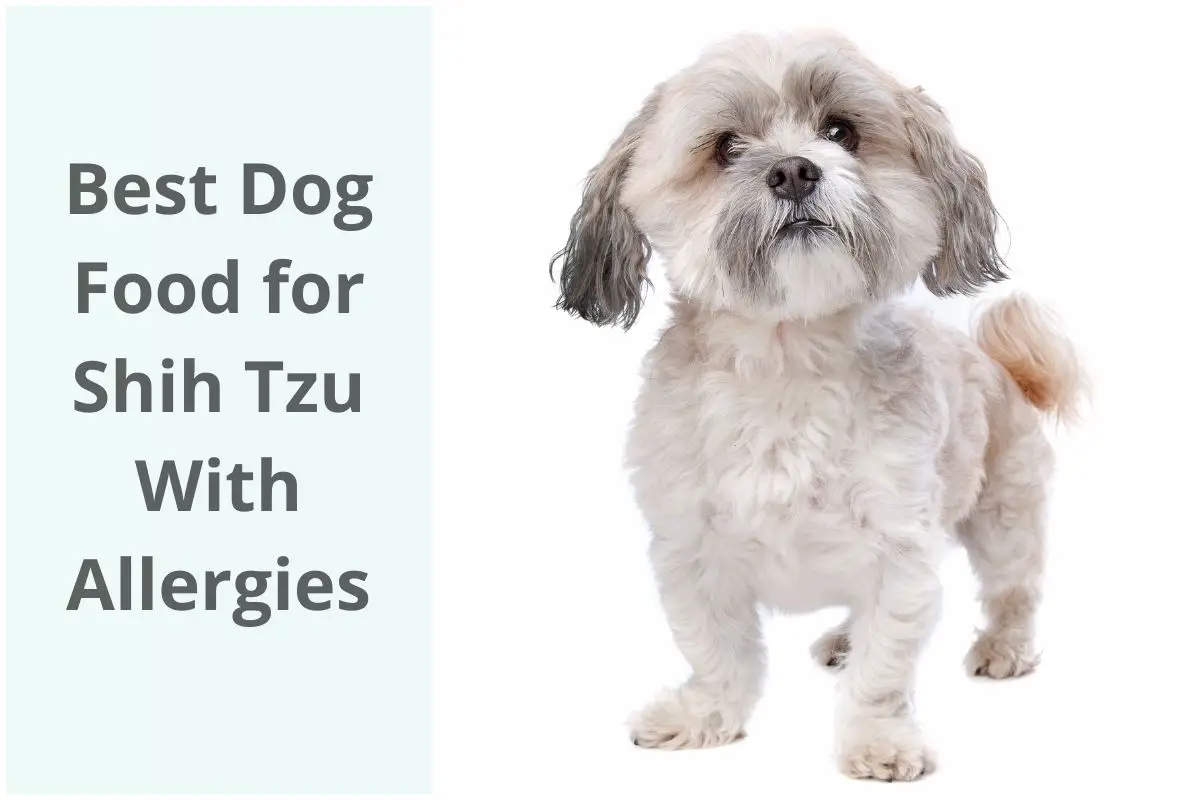This post contains affiliate links.
Kibble is dry dog food made from ground-up ingredients molded into pellets, cubes, or other shapes. Because dry dog food has a long shelf-life and is reasonably priced, it’s the most popular food among dog owners. However, not all dogs are keen on this dry dog food, so dog owners may need to find ways to make their canine’s food more appetizing.
To make your dog’s kibble more appealing, choose quality kibble and keep it stored to retain aromas and flavor. Consider adding water, broth, or wet dog food to soften the kibble and make it palatable. Add other ingredients like fruit, vegetables, meat, fish, or oils to make it more enticing.
Knowing how to make your dog’s kibble more tempting is beneficial to both pet owners and dogs. Read on to learn more about making kibble more delicious to your dog.
Table of Contents
Why Isn’t a Dog’s Kibble Appetizing?
In the wild, canine diets consist mainly of meat and some plant material. Their instincts attract them to a variety of food, from meat scraps to leftovers. As a result, kibble may be too bland. Commercial dog food wasn’t even a thing until 1860, but the understanding of pet nutrition has led to advancements that help us create well-balanced kibble.
Despite this, dry kibble isn’t always a canine favorite. Making dry kibble more appetizing isn’t just about adding other ingredients, although it is one option. First, it’s best to consider other methods, including food storage, exercise levels, meal timing, treat consumption, and temperature.
After you’ve tried those methods, you can work on adding foods to improve the look, feel, and aroma of your pet’s food to make it more enticing. What works will depend on your dog’s food preferences and whether any underlying health issues contribute to their lack of appetite.
Store the Food in an Airtight Container
Kibble has a long shelf-life because of its low moisture content. However, this doesn’t mean that you should just let the food sit in the bag. Once the bag is open, transfer the food into airtight containers to maintain freshness. Sometimes, bagged food goes stale and loses its enticing aromas and flavors that make it appealing to dogs.
If your pup is eating the food when it’s first opened but refusing it a few days later, it could be that the food is no longer palatable because it’s lost its freshness.
In some cases, kibble can go bad if stored in hot temperatures or damp environments. The food can grow bacteria and mold. A dog’s nose can pick up smells 100,000 times better than we can, so even if you can’t detect a discernible scent, he probably can. Not only will any unpleasant odors cause your dog to turn his nose away in disgust, consuming mold and bacteria can cause adverse health effects for your pooch.
Related articles:
Feed a Quality, Textured Dog Food
Sometimes, dogs won’t touch the kibble simply because they don’t like what’s in it. Whole, fresh food is best for dogs, but sometimes that’s not a feasible option. Fortunately, there are quality kibble choices, although they tend to be more expensive. Many cheap brands of dry kibble contain a lot of grain fillers. These grains aren’t palatable to our canine companions and can even be high in sugars and salts, which aren’t suitable for their health.
Experiment with different quality kibble brands to find one that your dog likes. You can buy smaller-sized bags to test your dog’s taste buds. Remember to transition slowly to avoid digestive upset. The process can take some time, but you must offer your dog food that he enjoys to encourage proper nutrition.
Consider trying different types of kibble, including some that have different textures. Some brands offer both hard, soft, and chewy pieces. Differing textures might make your pet more inclined to eat. Additionally, there are dry kibble brands that mix in freeze-dried raw food. These types of dry kibble are especially appealing to dogs, thanks to the aroma of raw meat.
Always consider your pet’s age, health, and activity level before choosing a food. You can discuss nutritional needs with your veterinarian. In general, puppies need higher protein and fat than older dogs.
Walk Your Dog Before Offering Food
Dogs benefit from exercise. Regular activity is critical to their mental well-being and physical health. When wolves hunt in the wild, they only eat after a long chase and takedown. It takes a lot of work and physical exertion before they’re able to reap the benefits of their efforts. This instinct is still present in many dogs.
However, that’s not to say that you should vigorously exercise your dog before eating, as this can lead to bloat and other serious digestive issues. A simple, leisurely walk is enough. It gives your dog a “job” to do, and then he’ll be rewarded with food. This can make the food more appealing.
Additionally, you can give your dog a job by offering his kibble in toys. These interactive feeding toys make the dog use his brain to access his food. It encourages the “work” instinct in dogs and slows the eating process to reduce bloat and digestive upset. There are dispensers, balls, mazes, and more. We recommend the AWOOF Pet Snuffle Mat on Amazon.
Feed When Your Pup Is Hungriest
Sometimes, making food more appealing is as simple as offering it at a different time of day. Maybe your dog doesn’t have much of an appetite in the morning when he first wakes up. Try feeding him in the afternoon or evening instead and see if that makes a difference.
When feeding, leave the food out for about half an hour. If your dog doesn’t touch it, remove it. Continue to do this each day until your pet starts to eat. When food is only offered at certain times, he might be more inclined to eat. If he continues to refuse food, try the other methods in this post or consider adding other foods to make it more enticing (as discussed later on).
Stop Feeding Too Many Treats & Table Food
Dogs spoiled with table scraps and treats are unlikely to find kibble very appealing. If they can have a piece of steak or a slice of cheese, why would they opt for dry dog food? Too many treats and table scraps can reduce appetite and lead to obesity in dogs. And dogs that are obese are more prone to health issues, including heart disease, diabetes, and musculoskeletal problems.
Pay attention to your dog. If he’s constantly begging for food during your mealtime and you give in, he knows that he can get what he wants. Stop feeding your dog extra food scraps and treats throughout the day, and see if his eating behaviors change.
Warm the Food to 101°F (38°C) To Release Aromas
Make your dog’s kibble more enticing by warming the food. This is difficult to achieve with dry kibble alone, but adding a bit of water can help. Experiment with different temperatures to see which one your dog prefers. Food warmed to 101 degrees Fahrenheit (38 degrees Celsius) lets off a more potent aroma than room-temperature foods.
Food can be heated in the microwave, but keep in mind that these appliances don’t always heat very evenly. Be sure that there are no scalding areas by testing the temperature with a food thermometer. Then, stir the food to distribute the heat evenly.
Add Other Ingredients to Your Dog’s Kibble
Sometimes the above methods are not enough to make kibble more appealing. If you’ve tried the above methods and your pup continues to refuse food, consider adding other ingredients to your pooch’s kibble.
Below, we’ll discuss ten different ingredients to boost the flavor and aroma of your dog’s food. Each of these ingredients is dog-friendly and provides benefits beyond just enhancing kibble.
Always discuss these ingredients with your veterinarian before introducing them to your pet. Remember to also add foods gradually to prevent digestive upset.
Soften the Food With Warm Water
When attempting to make a dog’s food more flavorful, water is the best place to start. It doesn’t add any extra ingredients; it only softens the food. Warm water can be added and stirred in to make a gravy-like liquid. The warmer temperature releases some of the aromatic compounds, which might make it more alluring to your dog.
Add Flavor With No-Salt-Added Broths
If water alone doesn’t work, consider trying a broth. Always use a no-salt-added chicken, beef, bone, or vegetable broth. You can even make your own at home to save money. Broths add flavor and aroma to the kibble and might encourage your furry friend to scarf it down.
Change the Texture With Wet Dog Food
Mixing wet dog food with kibble adds extra texture, flavor, and smells. There are many different wet dog foods to choose from. Choose one that contains ingredients that your pet has enjoyed in the past for the best results. If you’re feeding your dog grain-free kibble, choose a grain-free canned dog food to avoid introducing new ingredients into their diet.
Provide Extra Nutrition With Fruits and Vegetables
Adding vegetables like green beans, soft carrots, spinach, or kale can make a world of difference in your pet’s appetite. These nutrient-rich foods also add extra vitamins and minerals that your puppy might be lacking.
Pumpkin — a squash — is another option. Canned pumpkin is easy to store, high in fiber, helps in digestion, and tastes good for dogs. Ensure that it’s not pumpkin pie filling, as they contain sugar and spices that can negatively affect your pup.
Fruits are another option. In the wild, canines often munch on berries and other fruits. Bananas, apples, blueberries, and strawberries are all fine for your dog in moderation. They contain vitamins and offer different flavors and textures that might encourage your dog to chow down.
Chop Up Bits of Raw Meat To Mix In
Raw meat is an excellent choice for picky eaters. A wolf’s diet consists mainly of meat — including small game like squirrel, rabbit, and birds — but can include larger animals like deer and bison. Adding meat to their dry kibble might make the food more delicious. You can add raw diced beef or chicken to their bowls and see how they like it.
Fat trimmings and chicken skin are also options, as well as organ meat. Just be sure that there are no bones in the meat, as these create a choking hazard. If your dog is sensitive to high-fat diets, avoid fat trimmings and stick with the actual meaty flesh.
Give Them the Benefits of Fish
Fish is food readily available in the wild and an essential part of canine diets worldwide. Sardines, tuna, and anchovies are all excellent options that you can add directly to a dog’s kibble. Be sure that you’re using canned fish in water, not oil or sauce.
Alternatively, you can offer fish oil supplements. These capsules can be broken and poured into the food. The fishy aroma is likely to get the attention of your pup. Fish and fish oil are also high in omega-three fatty acids, promoting healthy skin and a shiny coat.
Consider Infusing Goats Milk or Kefir
While dairy products aren’t great for dogs. Goat milk is different, as it contains no lactose and is easier to digest. It is safe for dogs in small quantities, so a tablespoon here and there can make your dog’s kibble more palatable. Goat milk can also suppress allergies, but too much can lead to digestive upset.
Kefir, made from fermented goat’s milk, can also help to entice a dog to eat. A study published in the Journal of Dairy Science found that dogs ate more than 94% of the kefir within three minutes without coercion.
Add Eggs To Give Flavor, Protein, and Texture
Eggs are high in protein and other vitamins and nutrients that are beneficial to your pet. You can use raw, scrambled, or diced boiled eggs. They’re relatively inexpensive, so they’re a realistic option for enhancing the flavor of your canine kibble. You can even implement crushed shells for extra calcium. Eggs from range-free farm hens are best, according to the American Kennel Club, as store-bought eggs are often sprayed with chemicals.
Offer Probiotics in the Form of Yogurt
Yogurt is high in calcium, benefits your dog’s digestive system, and encourages a dog to eat when it’s mixed in with kibble. Any yogurt that you offer your pet should be plain and free of any added sweeteners. Artificial sweeteners, like xylitol, are toxic for dogs and should be avoided.
Choose a yogurt that has live cultures. Plain Greek yogurt is the best option because it contains live probiotics and lower lactose levels.
Add Virgin, Cold-Pressed Coconut Oil
Coconut oil is high in healthy fats and tastes delicious, even to canines. It’s high in lauric acid and contains medium-chain triglycerides (MCTs). Lauric acid has anti-inflammatory properties and MCTs aid in digestion and brain function. Virgin, unrefined, cold-pressed coconut oil is best for your pup.
Use coconut oil sparingly, as it’s high in saturated fat and can lead to loose, oily stools. Start by adding it to your dog’s kibble once a month, using a teaspoon at a time. If your dog tolerates it well, you can work up to a teaspoon per week.
Rotate Foods & Ingredients Weekly
In the wild, canine diets vary depending on the season and where they live. Wild dogs eat meat, internal organs, and bones. They eat plant and vegetable matter as well, including berries and fruit. Rotten fruit, herbs, and dead animals are also considered enticing if no other food options are available. They don’t eat grains in the wild because dogs cannot digest grains properly.
Wild dogs meet their nutritional needs over weeks, not one day. They’ll seek out the vitamins and minerals that they need by choosing different foods. By researching and offering other food options in addition to kibble, you can ensure that your pooch is getting what it needs.
Variety is the spice of life, even to canines. To keep kibble appetizing and prevent your dog from getting used to a specific type of food, rotate these ingredients in the kibble weekly. Dogs with diabetes, however, should eat a more consistent diet at the same time every day.
Medical Issues That Cause a Dog To Stop Eating
Is your dog still refusing to eat even after trying the above methods? If so, have your dog evaluated by a vet to rule out any underlying medical issues. Reduced appetite is common in dogs that are suffering from health conditions.
Leaving any health issues untreated can lead to even more problems and even death if the health issues are severe. Your dog should be seen by a veterinarian at least once a year and more often if he is sickly.
Some health conditions that can cause a dog to stop eating include:
- Infections: Bacterial infections can cause loss of appetite as well. You can treat them with antibiotics.
- Organ issues: Sometimes, loss of appetite indicates a more severe issue. Problems with the major organs can lead to a loss of appetite. Visit with your vet to discuss symptoms and the possibility of significant organ issues.
- Bowel obstruction: Sometimes, dogs chew on things that they shouldn’t, which can lead to stomach discomfort or even bowel obstruction, both of which can lead to loss of appetite. Contact your veterinarian to have a checkup to rule out a bowel obstruction.
- Parvovirus: Parvovirus can cause a loss of appetite and also be fatal. You can prevent this condition with proper vaccination.
- Kennel cough: This illness is usually mild but can present with loss of appetite.
- Parasites: Intestinal worms and other parasites can cause symptoms, including loss of appetite. Be sure to deworm your puppy and have a vet regularly examine your dog for signs of parasitic infections.
Because there’s a correlation between lack of appetite and health issues, it’s essential to rule out any health issues, especially before introducing any new foods into your pet’s diet. Always discuss any food changes with your vet.
Conclusion
Dry kibble is a food staple for dog lovers all over the world. They are easy to store, inexpensive, and can provide adequate nutrition with little work. On the other hand, dogs aren’t always enticed by dry pellets. By ensuring proper storage, food quality, timing, temperature, and exercise, you can entice your dog to consume his kibble. If all else fails, adding other ingredients to enhance the aroma and flavor may also help.
Sources
- Pet Food Institute: History of Pet Food
- KQED: How Your Dog’s Nose Knows So Much
- University of Illinois Urbana-Champaign: First Study on Human Grade Dog Food Says Whole, Fresh Food is Highly Digestible
- The Vet: Why Exercise Before or After a Meal Can Be Really Bad For Your Dog
- American Kennel Club: Obesity in Dogs – A Major Health Threat Hiding in Plain Sight
- Colorado State University: Canine Fish Oil Dosing Chart
- Journal of Dairy Science: Modulation of The Intestinal Microbiota of Dogs by Kefir as a Functional Dairy Product
- American Kennel Club: Can Dogs Eat Eggs?
- VCA Hospitals: Xylitol Toxicity in Dogs
- OSU.edu: Dog Nutrition
- TUFTS.edu: What’s The Best Diet for My Dog With Diabetes?
- American Kennel Club: Bowel Obstruction in Dogs
Mrdogfood.com is a participant in the Amazon Services LLC Associates Program, an affiliate advertising program designed to provide a means for sites to earn advertising fees by advertising and linking to Amazon.com. We also participate in other affiliate programs which compensate us for referring traffic.






